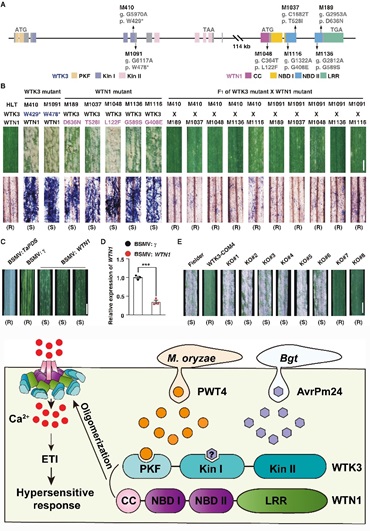TKPs are a recently discovered class of disease resistance proteins in wheat and barley. Characterized by two or more tandemly arranged kinase domains, these signaling proteins provide resistance against various fungal pathogens, including stripe rust, leaf rust, stem rust, powdery mildew, wheat blast, and smut. Their potential in breeding applications has garnered considerable attention.
The current study, which was published in Science (DOI:10.1126/science.adp5469) on March 28, expands the understanding of TKP functionality. It establishes a new paradigm for cooperation between TKPs and nucleotide-binding leucine-rich repeat (NLR) proteins—a type of immune receptor protein—in disease resistance. Specifically, the researchers discovered that an atypical NLR protein, WTN1 (Wheat Tandem NBD 1), partners with the TKP WTK3 to detect pathogen effectors and initiate immune responses, thereby conferring resistance to multiple fungal diseases in wheat.
With this discovery, the study bridges a critical gap in understanding immune regulatory pathways and offers a foundation for engineering crop varieties with broad-spectrum pathogen resistance.
Previously, the research team successfully cloned the broad-spectrum powdery mildew resistance genes Pm24 (WTK3) and Pm36 (WTK7-TM), both of which encode novel TKPs derived from Chinese wheat landrace and wild emmer wheat, respectively. However, key questions remained regarding how these resistance proteins recognize pathogen effectors, what functional roles their kinase domains play, and which immune pathways they activate.
To address these questions, the researchers screened ethyl methanesulfonate (EMS)-induced susceptible mutants of Pm24 (WTK3) and identified WTN1 as a pivotal component of the WTK3-mediated disease resistance pathway. Genetic analyses and genome editing demonstrated that WTN1 is essential for WTK3-mediated immunity against wheat powdery mildew. The WTK3-WTN1 pair operates via a sensor-executor cooperative model, with WTK3 not only conferring resistance to powdery mildew but also recognizing the wheat blast effector PWT4, thus extending its resistance potential.
Beyond its scientific impact, this study offers significant agricultural value. Pm24 (WTK3) originates from Chinese wheat landraces and has been successfully introduced into high-yield wheat varieties through backcrossing and marker-assisted breeding. These newly developed high-yielding disease-resistant germplasms have been freely distributed to domestic breeding institutions, addressing the scarcity of broad-spectrum powdery mildew resistance genes in China’s key wheat-producing regions.
Moreover, this breakthrough paves the way for establishing genetic barriers against wheat blast and supports sustainable agricultural development and industry advancements.
The characterization and breeding application of WTK3-WTN1 pair confering multiple disease resistance in wheat (Image by IGDB)
Contact:
Prof. LIU Zhiyong
Institute of Genetics and Developmental Biology, Chinese Academy of Sciences
Email: zyliu@genetics.ac.cn
 The characterization and breeding application of WTK3-WTN1 pair confering multiple disease resistance in wheat (Image by IGDB)Contact:Prof. LIU ZhiyongInstitute of Genetics and Developmental Biology, Chinese Academy of SciencesEmail: zyliu@genetics.ac.cn
The characterization and breeding application of WTK3-WTN1 pair confering multiple disease resistance in wheat (Image by IGDB)Contact:Prof. LIU ZhiyongInstitute of Genetics and Developmental Biology, Chinese Academy of SciencesEmail: zyliu@genetics.ac.cn CAS
CAS
 中文
中文




.png)
